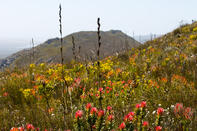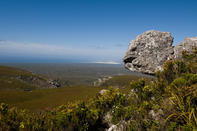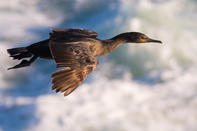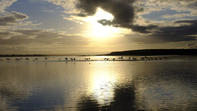Harold Porter National Botanical Garden
The most impressive of the small nature reserves in the Overberg region is the Harold Porter National Botanical Garden in Betty’s Bay, which is a satellite garden of Kirstenbosch. Other reserves include the Caledon Nature Reserve and Wildflower Garden, Fernkloof Nature Reserve in the Kleinrivier Berge behind Hermanus and the Bredasdorp Mountain Reserve.

With the exception of Potberg, which is the southernmost outcrop of Table Mountain Sandstone, most of the De Hoop Nature Reserve falls on a calcrete layer, concrete-hard limestone deposits that represent a raised sea bed.
The limestone-derived soil gives rise to a fynbos community unique to the southern Cape coastal region. Although the basic fynbos families are all well represented on these calcrete plains, the species are mostly quite different to those found on the protruding Potberg (which are more closely allied to the mountain fynbos communities).
De Hoop Nature Reserve

Of the approximately 8 500 plant species counted in the Cape Floral Kingdom, 1 500 are found in the Bredasdorp/Agulhas area. Of these, 108 species are considered to be rare or endangered, 50 species are endemic and 13 are either newly discovered or undescribed. The reason for so many species' status being precarious is due to the intense wheat cultivation here. However, it is on the rich shale-derived soils that most of this cultivation has occurred, and not on the poorer limestone soils.
Remnants of very rare south-coast renosterveld occur west of Potberg, where a small pocket of Bokkeveld Shale falls within the De Hoop Nature Reserve. The main habitats in the reserve are the rocky coastline east of Koppie Alleen, the beaches and sand dunes to the west (the largest such protected habitat in the country), the coastal plain, comprising limestone hills also known as dunes', the Potberg, and De Hoopvlei - a brackish lake. De Hoopvlei is, with Barberspan in the Transvaal, one of only two wetlands in the country registered at the Ramsar Convention as being of international importance as a wildfowl habitat – although there are many others, such as Verlorenvlei, that should be included on the convention's list. Although the vlei is an inland lake, the presence of marine organisms suggests that it was once a river estuary at least partly open to the sea, before the coastal dunes closed the mouth off 2.5 km from the present shoreline.
The northern shore of the lake is lined with limestone hills, behind which stands the elegant Cape-Dutch De Hoop homestead, now serving as park offices. If you are lucky, you may find the fossils of marine shellfish cemented into these cliffs. Above the vlei, gnarled milkwood (Sideroxylon inerme) trees, some hundreds of years old, stand on the plain; around the homestead the branches of wild fig (Ficus capensis) trees spread huge canopies across the lawns.
The reserve is attractive not so much for its wild herds as for the rare animals - such as mountain zebra, eland and bontebok that find refuge there. The type and structure of the vegetation mostly determine what animals will be found in specific habitats, as do the smaller invertebrates, which form a food link between the plants and many of the larger animals. Most visible of the animals are bontebok, eland. grey rhebok, duiker and steenbok. Small predators like caracal and mongooses are fairly common, while the remains of larger carnivores have been found in the dune sands.
Along the Overberg Coast

Reptiles are well represented by tortoises, terrapins and snakes, including potentially harmful ones like puffadders, boomslangs, and mysteriously beautiful Cape cobras, and, to a lesser extent, molesnakes.
The De Hoop Nature Reserve has the largest population of breeding and migrant birds, however (at the last count, there were 234 species of bird known to occur in the reserve), that generates the most interest. Along the coast, you might see shy black oystercatchers, small sanderlings and grey plovers scuttling after the retreating surf, white breasted cormorants, kelp gulls, giant kingfishers, egrets and herons near the vlei, rock kestrels, red wing starlings, and doves on the limestone cliffs.
The dunes between the reserve and Arniston are home to a breeding colony of 25 per cent of the world population of 3 000 Damara terns. This is the rarest coastal bird of southern Africa, being extremely sensitive to disturbance and like the oystercatcher - having a very low breeding success rate.
The sandy coastal plains are inhabited by, of course, ostriches, but also by black korhaans and Stanley bustards, capped wheatears, Namaqua sandgrouse, secretary birds, steppe and jackal buzzards, sunbirds, starlings and plovers.
Wild African Waterways

On the De Hoop Nature Reserve vlei lives 16 species of waterfowl; large waders like flamingoes and spoonbills; smaller waders such as plovers, sandpipers, stilts and avocets (and this does not include migrants such as curlew sandpipers); reed skulkers such as crakes, flufftails, moorhens and gallinules; the pelicans and seabirds that visit the lake; or even the two resident pairs of fish eagles whose high-pitched call is the song of the wild African waterways.
The most important inland birds, from a conservation perspective, are the vultures that nest on the southeastern cliffs of the Potberg. This is, ironically enough, the only remaining breeding colony of Cape vulture in the winter rainfall area. Recently, this species, endemic to Southern Africa, has been scratched from the endangered list due to the current success of breeding colonies in the Transvaal.
Caves on Potberg Shelter
Many caves on Potberg shelter houses important colonies of bats, of which there are five insectivorous and four fruitarian species, totalling a maximum summer population of 150 000.
The largest cave is used as a breeding colony by at least three species, most important of which is Scheiber's long-fingered bat. Other species include the Cape and Geoffrey's horseshoe bats, the Cape hairy bat and the Egyptian slit-faced bat. It has been estimated that the insectivorous species consume 410 kg of insects every night, which is a very effective form of biological insecticide for neighbouring farmers. The guano-thick cave floors host an independent ecosystem of fungi (52 species) and invertebrates (47 species).
 When headed to the Overberg, you’ll find a graveyard of ships and floral riches beyond compare along a coastline patrolled by great white ...
When headed to the Overberg, you’ll find a graveyard of ships and floral riches beyond compare along a coastline patrolled by great white ...